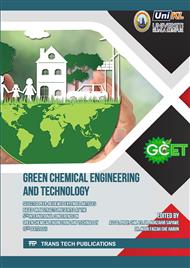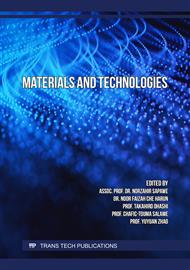[1]
Progress on sanitation and drinking water: 2015 update and MDG assessment on https://www.who.int/publications/i/item/9789241509145.
Google Scholar
[2]
S. R. Thakare and S. M. Ramteke, Fast and regenerative photocatalyst material for the disinfection of E. coli from water: Silver nanoparticle anchor on MOF-5, Catal. Commun. 102 (2017) 21–25.
DOI: 10.1016/j.catcom.2017.06.008
Google Scholar
[3]
E. Bahcelioglu, D. Doganay, S. Coskun, H. E. Unalan, and T. H. Erguder, A Point-of-Use (POU) Water Disinfection: Silver Nanowire Decorated Glass Fiber Filters, J. Water Process Eng. 38 (2020) 101616.
DOI: 10.1016/j.jwpe.2020.101616
Google Scholar
[4]
L. Beneduce, G. Spano, and S. Massa, Escherichia coli O157:H7 general characteristics, isolation and identification techniques, Ann. Microbiol. 53(4) (2003) 511–527.
Google Scholar
[5]
D. Mara and N. J. Horan, Handbook of Water and Wastewater Microbiology. Elsevier, London, (2003).
Google Scholar
[6]
S. J. Cavalieri, G. A. Bohach, and I. S. Snyder, Escherichia coli alpha-hemolysin: characteristics and probable role in pathogenicity, Microbiol. Rev. 48(4) (1984) 326–343.
DOI: 10.1128/mr.48.4.326-343.1984
Google Scholar
[7]
J.-W. Xu, Z.-D. Gao, K. Han, Y. Liu, and Y.-Y. Song, Synthesis of Magnetically Separable Ag3PO4/TiO2/Fe3O4 Heterostructure with Enhanced Photocatalytic Performance under Visible Light for Photoinactivation of Bacteria, ACS Appl. Mater. Interfaces. 6(17) (2014) 15122–15131.
DOI: 10.1021/am5032727
Google Scholar
[8]
Y. Ge, W. Shen, X. Wang, H. Feng, and L. Feng, Synthesis and bactericidal action of Fe3O4/AgO bifunctional magnetic-bactericidal nanocomposite, Colloids Surfaces A Physicochem. Eng. Asp. 563(5) (2019) 160–169.
DOI: 10.1016/j.colsurfa.2018.11.063
Google Scholar
[9]
M.-L. Kung, M.-H. Tai, P.-Y. Lin, D.-C. Wu, W.-J. Wu, B.-W. Yeh, H.-S. Hung, C.-H. Kuo, Y.-W. Chen, S.-L. Hsieh, Silver decorated copper oxide (Ag@CuO) nanocomposite enhances ROS-mediated bacterial architecture collapse, Colloids Surfaces B Biointerfaces. 155 (2017) 399–407.
DOI: 10.1016/j.colsurfb.2017.04.041
Google Scholar
[10]
Y.-H. Lyu, F. Wei, T. Zhang, L. Luo, Y. Pan, X. Yang, H. Yu, S. Zhou, Different antibacterial effect of Ag3PO4/TiO2 heterojunctions and the TiO2 polymorphs, J. Alloys Compd. 876 (2021) 160016.
DOI: 10.1016/j.jallcom.2021.160016
Google Scholar
[11]
L. Tian, X. Xian, X. Cui, H. Tang and X. Yang, Fabrication of modified g-C3N4 nanorod/Ag3PO4 nanocomposites for solar-driven photocatalytic oxygen evolution from water splitting, Appl. Surf. Sci. 430 (2018) 301–308.
DOI: 10.1016/j.apsusc.2017.07.185
Google Scholar
[12]
G. Panthi, R. Ranjit, H.-Y. Kim, and D. Das Mulmi, Size dependent optical and antibacterial properties of Ag3PO4 synthesized by facile precipitation and colloidal approach in aqueous solution, Optik. 156 (2018) 60–68.
DOI: 10.1016/j.ijleo.2017.10.162
Google Scholar
[13]
P. J. Mafa, R. Patala, B. B. Mamba, D. Liu, J. Gui, and A. T. Kuvarega, Plasmonic Ag3PO4/EG photoanode for visible light-driven photoelectrocatalytic degradation of diuretic drug, Chem. Eng. J., 393 (2019) 124804.
DOI: 10.1016/j.cej.2020.124804
Google Scholar
[14]
I. Ahmed, D. Ready, M. Wilson, and J. C. Knowles, Antimicrobial effect of silver-doped phosphate-based glasses, J. Biomed. Mater. Res. Part A, 79 (2006) 618–626.
DOI: 10.1002/jbm.a.30808
Google Scholar
[15]
P. Taheri and A. Khajeh-Amiri, Antibacterial cotton fabrics via immobilizing silver phosphate nanoparticles onto the chitosan nanofiber coating, Int. J. Biol. Macromol. 158 (2020) 282–289.
DOI: 10.1016/j.ijbiomac.2020.04.258
Google Scholar
[16]
S. Saengmee-Anupharb, T. Srikhirin, B. Thaweboon, S. Thaweboon, T. Amornsakchai, S. Dechkunakorn, A. Kamaguchi, Antimicrobial effects of silver zeolite, silver zirconium phosphate silicate and silver zirconium phosphate against oral microorganisms, Asian Pac. J. Trop. Biomed. 3 (1) (2013) 47–52.
DOI: 10.1016/s2221-1691(13)60022-2
Google Scholar
[17]
J. Seyfi, M. Panahi-Sarmad, A. OraeiGhodousi, V. Goodarzi, H. A. Khonakdar, A. Asefnejad and S. Shojaei, Antibacterial superhydrophobic polyvinyl chloride surfaces via the improved phase separation process using silver phosphate nanoparticles, Colloids Surf. B-Biointerfaces. 183 (2019) 110438.
DOI: 10.1016/j.colsurfb.2019.110438
Google Scholar
[18]
M. N. Gallucci, J. C. Fraire, A. P. V. Ferreyra Maillard, P. L. Páez, I. M. Aiassa Martínez, E. V. Pannunzio Miner, E. A. Coronado and P. R. Dalmasso, Silver nanoparticles from leafy green extract of Belgian endive (Cichorium intybus L. var. sativus): Biosynthesis, characterization, and antibacterial activity, Mater. Lett. 197 (2017) 98–101.
DOI: 10.1016/j.matlet.2017.03.141
Google Scholar



